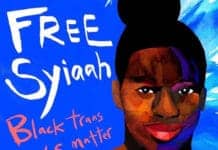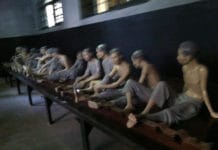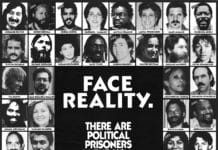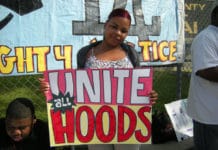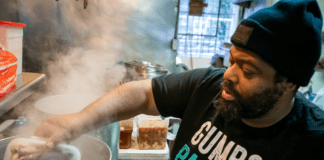by Laura Magnani
On July 8, 2013, 30,000 prisoners of the California prison system – and hundreds more across the United States – refused meals to take a stand about the conditions of prisoners in the various forms of solitary isolation – approximately 14,000 human beings in California alone.
It was the third hunger strike in California in two years. Dozens of prisoners deprived themselves of solid food for 60 days. One prisoner died.
The fact that these alleged gang leaders chose a nonviolent action and worked across all groups to reach agreement on the demands should be cause for celebration. But the California Department of Corrections and Rehabilitation (CDCR) characteristically took a dismissive and disrespectful tone in its responses and placed prisoners in even harsher conditions, citing them for disciplinary infractions as a result of the strike.
On July 8, 2013, 30,000 prisoners of the California prison system – and hundreds more across the United States – refused meals to take a stand about the conditions of prisoners in the various forms of solitary isolation – approximately 14,000 human beings in California alone.
What is behind this strategy of prisoners currently or formerly in Security Housing Units (SHU)? And where is this movement for change headed?
Hunger strikes in history and now
Hunger strikes have a long and revered history among nonviolent activists. Whether we look at the Irish prisoners’ historic hunger strike in 1981 that took the life of Bobby Sands and nine other strikers seeking recognition as political prisoners, or the six-day strike of Nelson Mandela that resulted in visitation rights for prisoners’ children, or the hunger strikes carried out by jailed suffragettes fasting to demand the right to vote prior to World War I, prisoners have frequently adopted this tactic to draw attention to their conditions.
When hikers Sarah Shourd, Shane Bauer and Josh Fattal inadvertently wandered in the vicinity of the border to Iran and were captured by Iranian troops, they were detained and later went on hunger strike to protest their conditions of confinement, bringing some improvements.
Hunger strikes have a long and revered history among nonviolent activists.
Such icons of nonviolence as Mohandas Gandhi and Cesar Chavez regularly employed the hunger strike to dramatize their issues. It is widely believed that Chavez permanently compromised his health as a result, perhaps hastening his early death.
More recently, immigrant detainees in private detention facilities in Washington and Texas started a hunger strike in March 2014 to protest conditions, sparking wide solidarity from immigrant rights advocates and some members of Congress, though it is not clear yet what changes they will achieve.
What has happened as a result of the hunger strike?
Back to California – we know of no other large group hunger strike that lasted 60 days. A great deal of public and media attention was focused on the strikers and brought their conditions and their demands to wider attention. Solidarity hunger strikes popped up among prisoners held in isolation units across the country, as word spread. Pressure mounted.
The California prisoners chose to suspend the strike, on Sept. 8, 2013, because legislators had stepped up and committed to holding hearings and introducing legislation, and prison administrators had agreed to sit down with prisoners to discuss the changes they were seeking. The signs of progress are several:
First, the meeting between hunger strike representatives and prison officials was held the week of Sept. 21 as promised – but the changes in conditions that were discussed are only now beginning to be implemented. There is a new “Property Matrix” which delineates many more property items available to SHU prisoners who can afford them, and prisoners are beginning to receive the added items. SHU visiting periods have been extended to three hours at Pelican Bay, a seven-hour drive from the Bay Area and twice as long a drive from Southern California.
Second, two joint legislative hearings have now been held in Sacramento – historic events because both the Assembly and Senate Public Safety Committees met together. (Transcripts of both hearings are available at http://prisonerhungerstrikesolidarity.wordpress.com/). Strong testimony, research and proposals were presented, all making clear that California is the “outlier” on this issue – isolating so many people for such long periods of time.

In each hearing, the real highlight was the long line of formerly incarcerated people, prisoners’ family members and community groups testifying for one minute each. It wasn’t long enough to develop an argument fully, but the overall impact was breathtaking. In the second hearing, this public testimony included 10 or more children of incarcerated parents, who delivered prepared testimony and created a strong drumbeat for compassion and a new reality.
Third, the Prisoner Hunger Strike Solidarity coalition has been working closely with both Sen. Hancock and Assemblymember Ammiano on ideas for legislation, yet both Public Safety Committee chairpersons are setting their own course with the legislation they are introducing. What is clear is that the public and key lawmakers are realizing the gravity of the problem and the need for comprehensive reform.
Many advocates on the outside would say reform is impossible for such a broken system; the whole apparatus needs to be stopped. Whether or not advocates end up supporting the details of proposed changes is not as important as what the proposals represent publically and politically. Serious change is afoot – indeed, it cannot be stopped.
In addition to the work in the state legislature, two congressional hearings have now been held on the topic, indicating that national interest is mounting.
Finally, change is happening at the administrative level with the roll out of a new framework for what used to be called gang validation and for creation of a new Step Down Program that will allow people to work their way out of the SHU without becoming informants.
However, the new framework moves California to a Security Threat Group approach, already in operation in many other states and very dangerous. It uses a homeland security lens to identify threat groups going all the way down to the street level, so it is gang validation by a different name, applied even more broadly.
The Step Down Program, though a direct result of proposals that came out of the second hunger strike, in the fall of 2011, is an astonishing four years in duration and could still result in indefinite SHU if some official in CDCR determines prisoners are not programming properly.
CDCR thinks these changes are revolutionary. They claim that they are “behavior based” rather than based on gang association, but their definitions of behavior are so broad that possession of photographs, cards, particular books or artwork continue to be treated as gang activity. The so-called offending content of these articles is highly racialized: for example, a book by George Jackson – often assigned reading in college classes – or art with Aztec symbols or greetings in Spanish. Security Housing Units continue to be the harshest example of prison racial profiling.
The most dramatic change we have seen so far is the case by case reviews that have been conducted following the second hunger strike. They are happening much more slowly than we had hoped – only around 750 hearings have been held as of this writing, but the statistics have stayed consistent: Over 60 percent of cases heard are resulting in transfer to general population!
Despite progress, retaliation and brutality continue as prisoners await systemic change
While significant efforts at change are underway or have happened, what too many prisoners are experiencing eight months later is retaliation against hunger strikers: transfers to more restrictive housing, loss of privileges, significant mail delays, worse food at Pelican Bay, less food and a dramatic rise in disciplinary write-ups which result in more solitary confinement and overall prison time. This amounts to a continued moral stain on California and more taxpayer money down the proverbial drain.
These harsh realities are an important part of the story, and more hard work by many is still needed in the trenches to follow up on the hunger strike and some prison victories.
While significant efforts at change are underway or have happened, what too many prisoners are experiencing eight months later is retaliation against hunger strikers.
As in any long struggle for justice, there is good news and bad news. It is very good news that many people are getting out of security housing units and administrative segregation after years of isolation. The bad news is the vast majority of prisoners in these units have not had their hearings yet and the 40 percent still assigned to unconscionable isolation that amounts to torture under international law. Perhaps even more alarming is the obvious question of why so many were held for so long in the first place?
For example, Hugo Pinell, held for 43 years, the longest held prisoner in isolation anywhere in the nation, was transferred out of Pelican Bay recently, when his case was finally reviewed. He is still in a Security Housing Unit, but according to CDCR officials he’s “in transition.”
Hugo has been disciplinary infraction-free since 1985 and still he was labeled “the worst of the worst” and was segregated in isolation until his hearing came up. His parole hearing, held in October, so shocked the Parole Board – he’d been eligible for parole since 1985 – that they postponed their decision in order to look into the case more fully. The follow-up has been scheduled for May 2, 2014. Go to www.hugopinell.com for more details.
The important law suit, Ashker v. Brown, is advancing and still looks like it will go to trial in November. The suit challenges California’s use of long term indefinite isolation on the grounds of the Eighth Amendment (cruel and unusual punishment) and the 14th Amendment (due process).
The other reality is that prisoner hunger strikes are popping up around the country, calling needed attention to abuses throughout prison systems. Whether you look at prisoners in Lucasville, Ohio, Menard, Illinois, or most recently undocumented prisoners in Tacoma, Washington, who went on hunger strike on what would have been Bobby Sands’ 60th birthday, the courage and dignity these strikers have shown is humbling and inspiring.
And last but not least on the list of accomplishments is the Call to End Hostilities, signed by 20 men at Pelican Bay of diverse racial and ethnic identities. Issued in 2012, this remains perhaps the most significant action, according to Sitawa Nantambu Jamaa, one of the four primary representatives of the hunger strikers. “Ending hostilities needs to be the new starting point,” he told me last week. “Violence begets violence on the streets and anywhere else. It was a new day when we saw how families are affected. It has to start from here.”
Personal reflections on this moment in history
I have been working for change for more than 40 years. The hunger strike came like a bolt of lightning and galvanized not only the people and families most directly affected, it also accelerated the efforts of a broad coalition of advocates for change, many legislators and the public. What the hunger-striking prisoners did has left the advocates much to build on.
I want to say as loudly as I can that more change is afoot than at any time in the history of the SHU, and perhaps in the history of corrections in California. Even the new property matrix will be reviewed every year, instead of the 30 years we’ve seen since the last comprehensive changes.
Both houses of the state Legislature have leading legislators introducing legislation that address CDCR’s actual practices and attempts to introduce more limitations and accountability. Sixty percent of the people receiving hearings are being transferred to general population and many others are being put in Steps 3 or 4, on the way to transfer. A way has been created out of security housing without becoming an informant.
This is all the result of the hunger strikes and the commitment of prisoners to stand up and tell the truth about what is happening to them. It is also the result of robust, unprecedented organizing on the outside – statewide – especially by family members! It is a remarkable moment. History is being made, though the struggle is far from over. There is strength and commitment to see it through.
Laura Magnani, who heads the American Friends Service Committee’s San Francisco office and is one of the inmate-chosen mediators for the Pelican Bay hunger strikers, can be reached at AFSC, 65 Ninth St., San Francisco, CA 94103, 415- 565-0201, sfoffice@afsc.org.

 Store
Store



